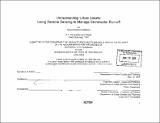| dc.contributor.advisor | Eran Ben-Joseph. | en_US |
| dc.contributor.author | Williams, Sarah Elizabeth, M.C.P. Massachusetts Institute of Technology | en_US |
| dc.contributor.other | Massachusetts Institute of Technology. Dept. of Urban Studies and Planning. | en_US |
| dc.date.accessioned | 2006-07-31T15:16:16Z | |
| dc.date.available | 2006-07-31T15:16:16Z | |
| dc.date.copyright | 2005 | en_US |
| dc.date.issued | 2005 | en_US |
| dc.identifier.uri | http://hdl.handle.net/1721.1/33603 | |
| dc.description | Thesis (M.C.P.)--Massachusetts Institute of Technology, Dept. of Urban Studies and Planning, 2005. | en_US |
| dc.description | Includes bibliographical references (p. 155-160). | en_US |
| dc.description.abstract | Many small suburban and rural communities have experienced increased growth as businesses and families leave city center is search of affordable land prices available at the cities periphery. As one might expect this increased growth is have an effect on the visual and environmental character of these communities. In some areas the rapid growth is also causing increases in stormwater run-off. High levels of run-off are in turn having adverse effects on these communities environment health, as it is degrading local water quality and damaging stream channels. Development in many of these same communities is causing them to fall under the regulation requirements of the Phase II, National Pollutant Discharge Elimination System (NPDES). Phase II has caused several of these small communities to think about the effects of stormwater for the first time. At the same time new high-resolution satellite imagery, with resolutions ranging from 4 to 1 meter square, became available from a series of satellites launched between 1999 and 2003. These new systems, with their increased resolutions, hold the potential to help small communities identify and manage their town's land resources. Of particular relevance is the possibility of using data acquired from these satellites to identify impervious surface coverage. Having a better understanding of impervious surfaces, which is directly correlated to volume of stormwater run-off, could help suburban communities manage their stormwater. Quantified impervious surfaces can be used in hydrologic models to predict effects of increased stormwater. An inventory of these surfaces might also assist towns in determining where stormwater Best Management Practices (BMPs) could implemented. | en_US |
| dc.description.abstract | (cont.) This study therefore tested whether suburban/rural communities could use new high resolution satellite imagery to map and measure impervious surfaces, in order to better manage and control the effects of stormwater run-off. The test performed in Billerica and Boxborough, MA found that although impervious cover measurements from satellite data are not as precise as planimetrics, the rough estimates provided, are a good resource for understanding the effects, mitigating, and planning for impervious coverage in growth communities. | en_US |
| dc.description.statementofresponsibility | by Sarah Elizabeth Williams. | en_US |
| dc.format.extent | 160 p. | en_US |
| dc.format.extent | 7696000 bytes | |
| dc.format.extent | 7705177 bytes | |
| dc.format.mimetype | application/pdf | |
| dc.format.mimetype | application/pdf | |
| dc.language.iso | eng | en_US |
| dc.publisher | Massachusetts Institute of Technology | en_US |
| dc.rights | M.I.T. theses are protected by copyright. They may be viewed from this source for any purpose, but reproduction or distribution in any format is prohibited without written permission. See provided URL for inquiries about permission. | en_US |
| dc.rights.uri | http://dspace.mit.edu/handle/1721.1/7582 | |
| dc.subject | Urban Studies and Planning. | en_US |
| dc.title | Understanding urban assets : using remote sensing to manage stormwater run-off | en_US |
| dc.title.alternative | Using remote sensing to manage stormwater run-off | en_US |
| dc.type | Thesis | en_US |
| dc.description.degree | M.C.P. | en_US |
| dc.contributor.department | Massachusetts Institute of Technology. Department of Urban Studies and Planning | |
| dc.identifier.oclc | 64178467 | en_US |
